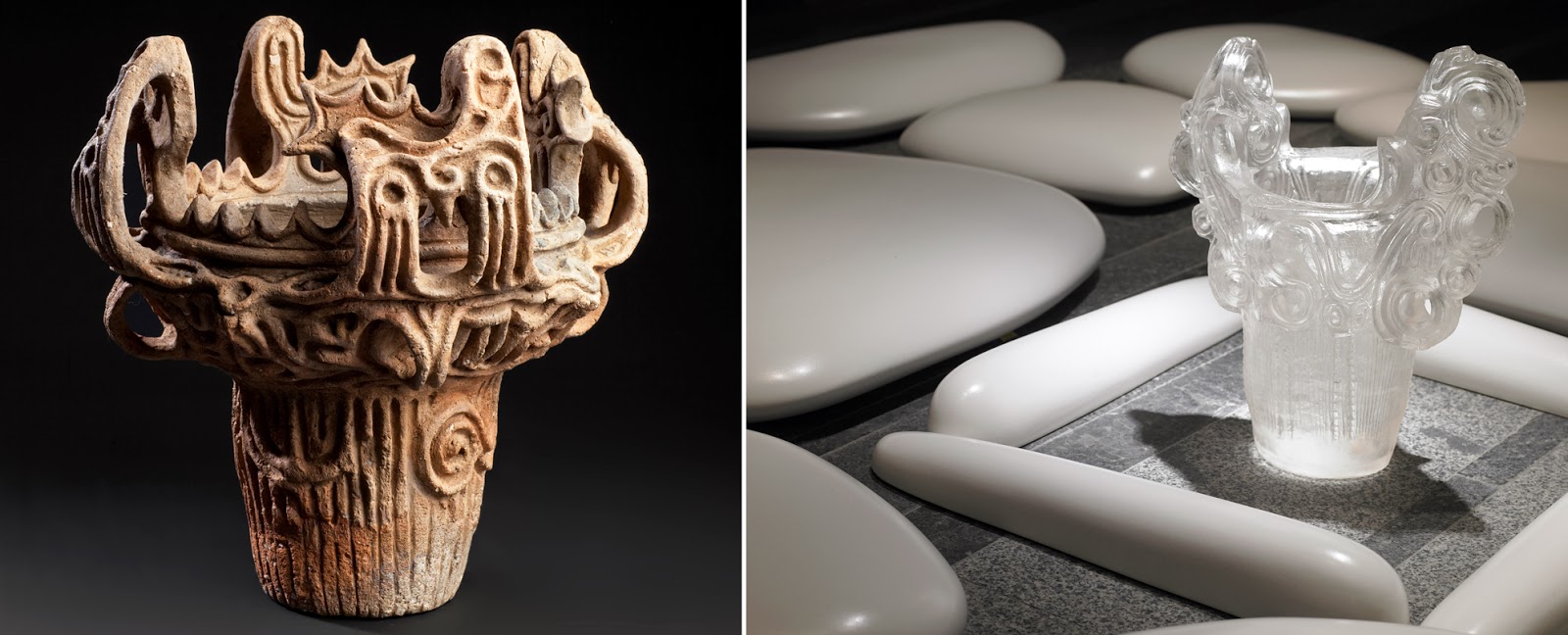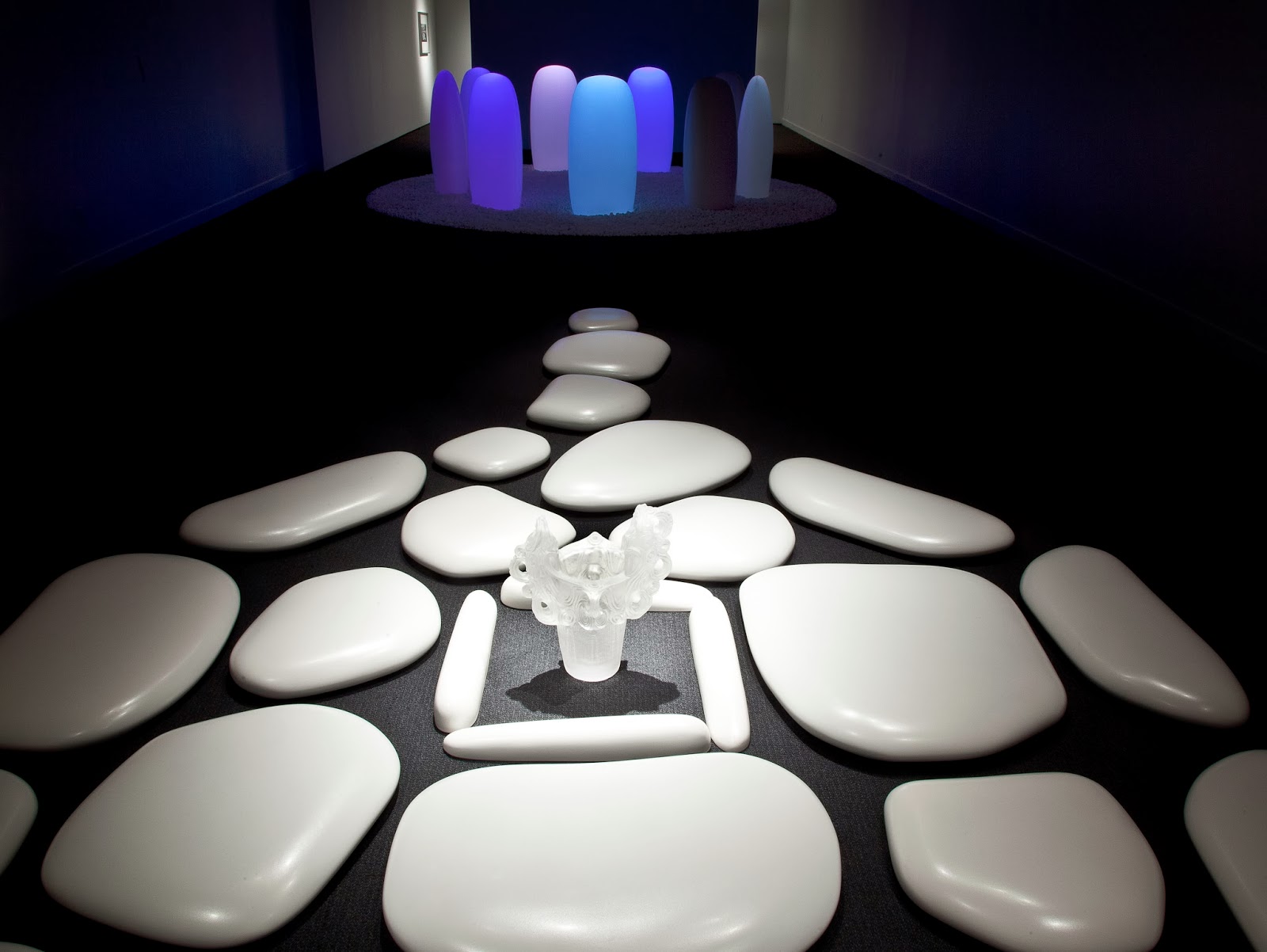 Sister Cisterns: Mori's
(right) mirrors a
from 3,500–2,500 BCE.She wears all white and a calm smile. Somewhere in her artistic wanderings, she’s traveled the universe. Seen black holes and white holes. Watched stars be born and die, spilling their insides onto the canvas of space.
Sister Cisterns: Mori's
(right) mirrors a
from 3,500–2,500 BCE.She wears all white and a calm smile. Somewhere in her artistic wanderings, she’s traveled the universe. Seen black holes and white holes. Watched stars be born and die, spilling their insides onto the canvas of space.
Not what you’d expect from someone reaching back sixteen millennia in her art.
In her recently opened solo exhibition , Mariko Mori combines a range of styles and beliefs: New Age spirituality, technological futurism, a little Buddhism, Shinto influences. Some will have no trouble tapping into the show’s meditative wavelength and sense of renewal. Others might get lost in the exhaust of complexity and primal energies. What no one can deny is the presence of the ancient, brought to light in 2013 from the memory of Jōmon.
Best known for their stone circles and intricate pottery, the people of Jōmon Japan lived roughly between 14,000 and 300 B.C.E. They were, as far as we can tell, the first to “[master] the technology of transforming pliable clay into hard and durable containers,” with contemporary scholarly debate centered on the practical and artistic relevance of these artifacts, according to Junko Habu's .
Mori began her study of the period with fieldwork at Jōmon archaeological sites like Ōyu, Sannai Maruyama, and Miwayama, home to several of the stone circles and spherical stones that have remained intact through the millennia. From this fieldwork, in addition to collaboration with Chief Curator at Aomori Museum of Art, Iida Takayo, came the initial exhibition, , that prepared the way for the artist's current .
 Mori's
leads to
Merely viewing the separate pieces in Mori’s exhibit may puzzle some visitors. After all, a 5,000-year-old Jōmon vase and the LED-powered monoliths of
don’t exactly seem like bedfellows. It’s only after reading more about the people of prehistoric Japan that the connection is made.
Mori's
leads to
Merely viewing the separate pieces in Mori’s exhibit may puzzle some visitors. After all, a 5,000-year-old Jōmon vase and the LED-powered monoliths of
don’t exactly seem like bedfellows. It’s only after reading more about the people of prehistoric Japan that the connection is made.
The fact that the Jōmon era is named after the cord markings adorning the pottery gives one an idea of how much these artifacts have come to represent the beliefs, lifestyles, and history of an enigmatic people. All can agree to their importance, but this is where the consensus ends. Whether the pots were used in religious ritual as an embodiment of animistic belief, or they are the tools of a society of hunter-gatherers is a matter of great debate. If the latter—and recent studies suggest the pots may have been used to store fish—it would upend the idea that clay pottery was impractical for a people constantly on the move. Then again, it takes no great effort of the imagination to see the designs as the “ripples and eddies on the surfaces of the salmon-rich river,” as Iida Takayo describes them, rather than the flames from which the pots, or , take their name.
Jōmon stone figurines and monoliths have proven equally difficult to explain. While some , or figurines, call to mind the famous “Venus” figurines of Paleolithic Europe and Asia—both types emphasize the hips and breasts, suggesting ties to fertility—others defy classification. These oddities feature a combination of human and animal features, such as with horns or a cat head. Some hold a secret inside; one figure discovered in Nagashiki, Kanagawa Prefecture, contained bone particles and teeth from a child.
Writing on the topic of in 1974, Johannes Maringer traced a connection between the figurines and the Jōmon peoples’ belief in animals as “ epiphanies of higher beings.” Other artifacts help us approach an idea of the Jōmon religious worldview. For example, Simon Kaner argues that the arrangement of bodies in burial grounds at Sannai Maruyama, one of the largest Jōmon settlements ever unearthed, suggests both a belief in the afterlife and a kind of ancestor worship.
While some have theorized that Jōmon peoples’ overdependence on ritual contributed to their downfall against the rice-based Yayoi civilization, Kaner contends it was these very rituals that allowed their successful assimilation. After all, he says, at the core of Jōmon religious practice is a belief in the power of the individual to transform.
By combining Jōmon art styles with modern techniques—one of Mori’s pieces, , features an acrylic recreation of an ancient Jōmon vase at its center—Mori sets to capture the fluidity of life, death, and inspiration. Those people of millennia past are not so much an interesting historical subject as a living pulse. “My body contains genes inherited from our earliest ancestors,” Mori says in the catalogue accompanying the exhibition, “and those genes can produce a strong reaction when they try to arouse that special consciousness which slumbers deep within me.”
In his essay, Kaner cites Kobayashi Tatsuo and others as setting forth the theory that the people of Jōmon Japan may have used ritual not to assimilate into the Yayoi, as he himself believes, but to resist them and the revolutionary agricultural lifestyle they represented. The idea is particularly intriguing when we consider Mori and her artistic transformation over the last decade, from pointed critic of consumerism and the super-modern to student of both prehistoric and New Age spiritualism. You almost wonder if Mori isn’t using her own ritual, her art, to mount a largely silent resistance against the strange times in which we live.
Photos(clockwise): flame-ware vase, Middle Jōmon period (3,500–2,500 BCE), Earthenware, 11 5/8 inches high, 11 5/8 inches diam, collection of John C. Weber; Mariko Mori's (2006), ceramic stones and acrylic vase; 192 x 124 x 3 ½ inches, courtesy of SCAI THE BATHHOUSE, Tokyo and Sean Kelly, New York; FOREGROUND: , BACKGROUND: , 2004. Stone, Corian, LED, real-time control system, 132 3/8 inches diam., each stone 43 3/8 × 22 1/4 × 13 1/2 inches, courtesy of The Mori Art Museum, Tokyo, Installation photograph by Richard Goodbody.
http://www.japansociety.org